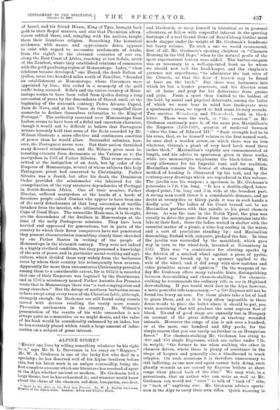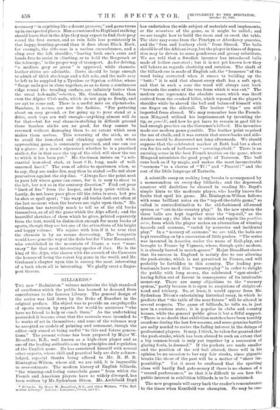ALPINE SPORT.*
EVERY one lives by selling something whatever be his right to it," says Mr. R. L. Stevenson in his essay on "Beggars." Mr. W. A. Grohman is one of the lucky few who deal in a specialty; he has deserved well of his Alpine brethren before this, but his latest work is an unique commodity, being the first complete account which our literature has received of sport in the Alps, whether ancient or modern. Mr. Grohman had a large theme, but he has exhausted it; and whoever would know about the chase of the chamois, red-deer, bouquetin, roe-deer, • Sport in the Alps in the Past and Present. By W. A. Baillie Orohman, Member of the Alpine Club. London: Adam and Charles Black.. and blackcock, or steep himself in historical as in personal adventure, or follow with respectful interest in the sporting footsteps of a real Grand Duke (of Saxe-Coburg Gotha) must needs stagger under the weight of Mr. Grohman's handsome but heavy volume. To such a one we would recommend, first of all, Mr. Grohman's opening chapters on "Chamois Hunting in the Old Days," when to the natural perils of the sport supernatural terrors were added. The barber-surgeon was as necessary to a well-appointed hunt as he whom we should now call the head-keeper, and the chaplain's presence not superfluous, " to administer the last rites of the Church, so that the door of heaven may be found at least on the latch." Bat there were fastnesses into which let but a hunter penetrate, and his director must sit at home and pray for his deliverance from gnome and pixie. From a sport thus limited to the boldest of the bold, by moral and physical deterrents, among the latter of which we must bear in mind how inadequate were a sportsman's arms, we expect to find scant literary records. Two survive, JVeisskunig and Theuerdank, both in black- letter. These were the work, or "the creation" as Mr. Grohman cautiously puts it, of the same pen, Maximilian's, the Emperor (1459-1519), greatest of mediteval bowmen " since the time of Edward III." " Such strength had he in his arms, that, as he himself relates in the first-named work, he once shot a wooden arrow, on which there was no iron whatever, through a plank of very hard larch wood three inches thick." Maximilian's exploits are commemorated at length, and his advice to sportsmen given in these works, while two manuscripts supplement the black-letter. With every allowance for his Imperial rank and for tradition, Maximilian remains the Nestor of chamois-hunting. His method of hunting is illustrated by his text, and by the contemporary drawings which are reproduced in this volume. The javelin was his weapon ; a specimen in Mr. Grohman's possession is 7 ft. 8 in. long. " It has a double-edged, lance- shaped point, 7 in. long and 2 in. wide at the broadest part. A strong man could throw it a considerable distance, and no doubt at twenty-five or thirty yards it was in such hands a deadly arm." The ladies of his Court turned out to see Maximilian perform with this missile at his great chamois drives. As was the case in the North Tyrol, the plan was usually to drive the game down from the mountains into the lake at their foot ; there the ladies waited in shelter with the essential matter of a picnic, a wine-keg cooling in the water, and a cart of provisions standing by ; and Maximilian descending, flashed with conquest, pledged the fair. In time the javelin was succeeded by the matchlock, which gave way in turn to the wheel-lock, invented at Nuremberg in 1515. This was "a contrivance for eliciting sparks by the friction of a notched wheel against a piece of pyrite. The wheel was bound up by a spanner applied to the axle of the wheel, and it did away with slow matches and other primitive means of ignition." On the weapons of to- day Mr. Grohman offers many valuable hints, distinguishing between deer-stalking and chamois-stalking. For chamois- stalking he recommends the ordinary rifle in use in Highland deer-stalking. If you would stalk deer in the Alps, however, a more powerful rifle is necessary,—" a -500 Express will not be found too heavy an arm. For these giants take a lot of lead to grass them, and as it is very often impossible in these dense woods to place the bullet where it should be put, you want something that will produce the most copious flow of blood. No end of good stags are annually lost in Hungary on account of the great difficulty in tracking wounded animals. Moreover the range of aim is not over a hundred, or at the most, one hundred and fifty yards, for the simple reason that you can rarely see further in an Hungarian forest." For chamois-stalking Mr. Grohman has clung to -400 and -450 single Expresses, which are rather under 7 lb. in weight, "the former to use when stalking, the other in chamois drives, where there is plenty of assistance in the shape of keepers and generally also a bloodhound to track cripples. On such occasions it is therefore unnecessary to risk inflicting, as one now and again cannot help doing, such ghastly wounds as are caused by Express bullets at short range when placed back of the ribs." We may wish, in a parenthesis, that an author who can write as well as Mr. Grohman can would not " elect " to talk of " back of " ribs, or " back of " anything else. Mr. Grohman advises sports- men in the Alps to carry their own rifles. Quick shooting is
necessary " in anything like a decent preserve," and game turns up in unexpected places. Men accustomed to Highland stalking should learn that in the Alps they may expect to find their prey round the first corner, and as rain falls less persistently in that happy-hunting-ground than it does about Black Rock, for example, the rifle-case is a useless encumbrance, and a sling over the left shoulder, "leaving both one's arms and hands free to assist in climbing, or to hold the Bergstock or the telescope," is the proper way of transport. As for driving, "a medium grey or green" is approved, while chamois- leather shirts are advisable. Boots should be large enough to admit of thick stockings and a felt sole, and the nails may be left to be supplied by a Tyrolese or Styrian cobbler, whose " flange nails put in close together, so as to form a continuous ridge round the treading surface, are infinitely better than the usual hob-nails,"—better, Mr. Grohman thinks, than even the Alpine Club nails, which do not grip so firmly, and are apt to come out. There is a useful note on alpenstocks. Bamboos, it seems, are now the fashion. "For pottering about on easy ground, or for going up to your stand at a drive, such toys are well enough—anything almost will do for that—but for real chamois-stalking in difficult ground these bamboo sticks are no good, for they cannot be reversed without damaging them to an extent which soon makes them useless. This reversing of the stick, so as to avoid the iron-shod end chinking against rock when approaching game, is constantly practised, and one can see by a glance at a man's alpenstock whether he is a practised stalker, for in that case the top of the stick will show the use to which it has been put." Mr. Grohman insists on "a sub- stantial iron-shod stick, at least 6 ft. long, made of well- seasoned hazel." The sum of advice to sportsmen when, so to say, they are under fire, may thus be stated :—Do not show yourselves against the sky-line. " Always face the point next to your left where game can come, for it is easy to shoot to the left, but not so in the contrary direction." Find out your " limit of fire " from the keeper, and keep quiet within it. Lastly, do not leave your place till the drive is over, lest you be shot or spoil sport; "the wary old bucks dash out often at the last moment when the beaters are right upon them." Mr. Grohman has naturally much to tell us of the old backs themselves, as of all the game which the Alps afford ; and the beautiful sketches of them which he gives, printed separately from the text, would be distinction enough for many books of sports, though they are but one of the attractions of his bright and happy volume. We rejoice with him if it be true that the chamois is by no means decreasing. The bouquetin would have gone the way of the dodo but for Victor Emmanuel, who established in the mountain of Cogne a vast " sanc- tuary " for that most interesting species of ibex. He is the king of the Alps, who shares with the auroch of the Caucasus the honour of being the rarest big game in the world, and Mr. Grohman's chapter upon him is among the most interesting of a book where all is interesting. We gladly erect a finger- post thereto.



















































 Previous page
Previous page